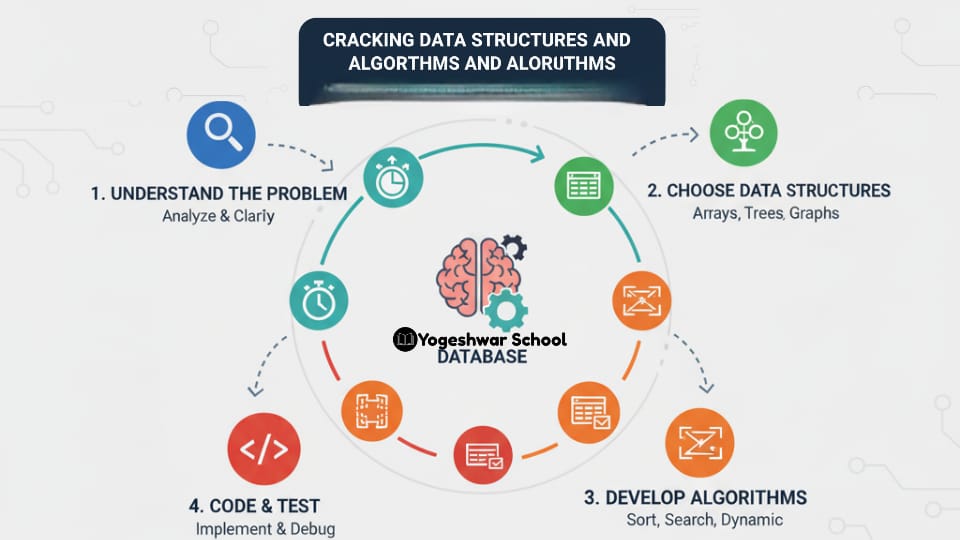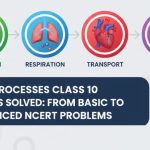JumpTo!
Data structure and algorithms form the foundation for almost every software you interact with daily—from GPS and search engines to AI chatbots and gaming applications. When you’re browsing the internet, using mobile apps, or asking ChatGPT a question, you’re essentially benefiting from efficient DSA implementation behind the scenes.

Furthermore, if you’re aiming for a career in tech, mastering these concepts is non-negotiable. Top companies like Google, Microsoft, Amazon, Apple, and Meta heavily focus on DSA during their interview processes. This is no coincidence—these organizations understand that strong data structures and algorithms skills directly translate to better problem-solving abilities and stronger programming capabilities. Actually, data structures help organize information effectively when performing various operations, making them crucial for solving complex problems such as the Knapsack problem, Tower of Hanoi, and shortest path algorithms.
Learning data structures and algorithms might seem daunting at first, but a structured roadmap can make this journey manageable. Specifically, resources like roadmap.sh (with 339K GitHub stars and over 2.1 million registered users) provide clear pathways for mastering these fundamental concepts. Throughout this article, you’ll discover a step-by-step blueprint that even Google engineers follow to become proficient in DSA.
Understanding the Basics of Data Structures and Algorithms
The foundation of computer science rests upon two pillars: data structures and algorithms. These concepts work together to solve computational problems through organized storage and systematic processing.
What is data structure and algorithms?
Data structures are specialized formats for organizing and storing data efficiently. They provide methods to access, manipulate, and modify information while optimizing specific operations. Think of them as containers designed to hold information in ways that make particular tasks faster or more memory-efficient. Common examples include arrays, linked lists, stacks, queues, trees, and graphs—each offering unique advantages for different scenarios.
Meanwhile, algorithms are step-by-step procedures or instructions for solving specific problems. They define the logic for manipulating data and producing desired outputs. Algorithms aim to solve problems efficiently, considering both time complexity (execution speed) and space complexity (memory usage). Effective algorithms must consistently produce correct results for all valid inputs and scale well with different dataset sizes.
Difference between data types and data structures
Though often confused, data types and data structures serve distinct purposes:
| Aspect | Data Types | Data Structures |
|---|---|---|
| Definition | Specifies what kind of values a variable can store | Organizes collections of data for efficient operations |
| Focus | Individual data elements and their properties | How multiple elements are arranged and related |
| Examples | Integers, floating-point numbers, characters, booleans | Arrays, linked lists, trees, graphs, hash tables |
| Operations | Basic arithmetic and comparison operations | Complex operations like searching, sorting, traversal |
| Implementation | Abstract, defined by programming languages | Concrete, with specific memory organization |
Unlike basic data types that represent single values, data structures can hold collections of different types within one object. Additionally, while data types focus on individual elements’ nature, data structures concentrate on relationships between elements and efficient access patterns.
Why algorithms need data structures to work efficiently
Algorithms and data structures maintain a symbiotic relationship—neither reaches its full potential without the other. Consequently, choosing the appropriate data structure dramatically impacts an algorithm’s performance.
Consider searching for information: using an unorganized list requires checking each element sequentially, whereas a properly structured binary search tree can find results exponentially faster. The right data structure reduces computational complexity, enhances memory usage, and improves execution speed.
Data structures also enable algorithms to:
- Store intermediate results during computation
- Represent complex relationships between data elements
- Access information in patterns that match the problem’s needs
For instance, graph data structures allow shortest-path algorithms to represent connections between locations, making navigation applications possible. Similarly, hash tables enable constant-time lookups, allowing algorithms to retrieve information almost instantaneously regardless of dataset size.
This partnership explains why understanding both concepts together is crucial—algorithms provide the “how” while data structures provide the “where” in problem-solving.
Core Data Structures Explained with Examples
Every robust software system relies on core data structures to organize and process information effectively. These fundamental building blocks serve as the backbone for countless applications, from web browsers to database systems.
Arrays and Linked Lists: Sequential vs Dynamic Memory
Arrays store elements in contiguous memory blocks, enabling O(1) constant-time access through indexing. This contiguous allocation makes arrays cache-friendly, improving performance through spatial locality. In contrast, linked lists utilize non-contiguous memory allocation where nodes connect via pointers, allowing O(1) insertion and deletion in the middle. Despite slower element access (O(n)), linked lists excel in dynamic environments where frequent modifications occur without predetermined size requirements.
Stacks and Queues: LIFO and FIFO in action
Stacks operate on the Last-In-First-Out (LIFO) principle—think of a stack of books where you can only add or remove from the top. This structure powers function calls, undo/redo operations, and expression evaluation. Conversely, queues implement First-In-First-Out (FIFO)—resembling a line at a checkout counter. Queues handle task scheduling, resource management, and process coordination in computing systems. Both structures can be implemented using arrays or linked lists depending on operational priorities.
Trees and Graphs: Hierarchical and Networked Data
Trees represent hierarchical relationships through a root node with child nodes, without cycles. They efficiently organize file systems, DOM structures, and databases. Graphs extend this concept by allowing cycles and multiple connections between nodes, representing complex networks. At Google, graph structures power PageRank algorithms for determining webpage importance based on link relationships.
Hash Tables: Constant Time Lookup
Hash tables provide remarkable O(1) average lookup time by mapping keys to array indices using hash functions. This makes them invaluable for database indexing, caching, and implementing associative arrays. They handle collisions through techniques like chaining (using linked lists) or open addressing (probing for next available slot).
Heaps and Priority Queues: Efficient Scheduling
Heaps, typically implemented as complete binary trees, maintain either min or max values at the root. Priority queues leverage heap structures to arrange elements based on priority values rather than insertion order. This capability makes them essential for job scheduling, CPU task management, and algorithms like Dijkstra’s shortest path.
Essential Algorithms Every Engineer Should Know
Mastering algorithms is crucial for solving complex computational problems efficiently. An in-depth understanding of these systematic procedures empowers engineers to tackle challenges across various domains.
Sorting Algorithms: Quick Sort, Merge Sort, Heap Sort
These three comparison-based sorting algorithms offer different performance characteristics. Quick Sort uses a divide-and-conquer approach by selecting a pivot element and partitioning the array accordingly. It performs at O(n log n) in average cases but can degrade to O(n²) in worst scenarios. Merge Sort, equally powerful, consistently delivers O(n log n) performance regardless of input by dividing the array in half, sorting each portion, then merging results. Heap Sort leverages a binary heap data structure, offering O(n log n) performance without Quick Sort’s worst-case pitfalls.
Searching Algorithms: Binary Search, BFS, DFS
Binary Search requires sorted data but delivers remarkable O(log n) efficiency compared to linear search’s O(n) time. For tree and graph traversal, Breadth-First Search (BFS) explores all neighbors before moving deeper using queues for level-by-level exploration. Depth-First Search (DFS) dives deep into branches before backtracking, typically implemented using recursion or stacks.
Recursion and Divide & Conquer Techniques
This powerful paradigm breaks problems into smaller sub-problems, solving them independently before combining results. Notable examples include Karatsuba’s multiplication method, FFT algorithms, and the sorting algorithms mentioned earlier. The approach often leads to efficient algorithms with improved cache usage on modern processors.
Greedy Algorithms and their use cases
Greedy algorithms make locally optimal choices at each step, hoping to find global optima. They excel when problems have:
- Greedy choice property
- Optimal substructure
Applications include Dijkstra’s shortest path algorithm, Huffman coding, and the Fractional Knapsack problem. However, they don’t guarantee optimal solutions for all problems, notably failing in cases like the 0/1 Knapsack problem.
Dynamic Programming: Memoization and Tabulation
These techniques address overlapping subproblems, yet differ significantly in implementation. Memoization uses a top-down approach with recursion, storing results in a table and filling entries as needed. Tabulation takes a bottom-up approach through iteration, systematically building solutions from smallest subproblems upward. Generally, tabulation delivers better performance without recursion overhead, although memoization often produces more intuitive code.
Real-World Applications and Interview Relevance
Beyond theoretical foundations, data structures and algorithms power real-world systems across tech industries. Their practical applications highlight why they remain critical skills for engineers and developers today.
How Google uses DSA in search and indexing
Google’s search engine relies on sophisticated data structures and algorithms to deliver relevant results within milliseconds. The process begins with crawling, where Google’s algorithms systematically discover and analyze web content. Subsequently, the indexing phase organizes this vast information into optimized structures for rapid retrieval. This indexed data enables Google to generate dynamic search results in real-time based on user queries, ensuring high relevance through content-based targeting.
Common DSA problems in coding interviews
Top tech companies like Google, Amazon, Microsoft, Facebook, Flipkart, and Swiggy consistently evaluate candidates on DSA proficiency. Common interview questions include:
- Implementation of fundamental structures (arrays, linked lists, stacks, queues)
- Tree and graph traversal algorithms
- Dynamic programming problems
- Hash table applications
Interestingly, hash tables emerge as perhaps the most frequently used data structure in algorithm questions. When stuck on a problem, many interviewers recommend methodically considering each potential data structure and its application to the challenge.
Optimizing code with the right data structure
Selecting appropriate data structures dramatically impacts performance. For instance, at Skyscanner, flight routes are represented as directed graphs with weighted edges, allowing the implementation of modified A* search algorithms to calculate the cheapest routes between cities. Moreover, navigation systems like Google Maps represent road networks as graphs, applying Dijkstra’s algorithm to determine optimal routes.
DSA in machine learning and AI systems
Throughout AI and machine learning development, data structures provide the foundation for managing large data volumes efficiently. Arrays and lists frequently represent datasets and feature vectors, whereas trees power decision-based models like random forests. Particularly in natural language processing, tries enable tasks such as autocomplete and spell-checking, plus sparse matrices optimize storage for high-dimensional but sparse datasets.
Mastering data structures and algorithms proves essential for anyone serious about a career in technology. Throughout this guide, you’ve seen how DSA forms the foundation of virtually every software application—from search engines and navigation systems to AI-powered tools. Most importantly, these concepts aren’t merely theoretical exercises but practical skills applied daily by engineers at leading tech companies.
As demonstrated, data structures provide organized methods to store information, while algorithms offer systematic approaches to process that data. Together, they create powerful solutions to complex computational problems. Additionally, understanding when to apply specific structures—whether arrays for sequential access, trees for hierarchical relationships, or hash tables for constant-time lookups—significantly impacts your code’s efficiency.
The step-by-step blueprint outlined here mirrors approaches used by professional engineers, including those at Google, Amazon, and Microsoft. Therefore, following this roadmap will not only strengthen your programming fundamentals but also prepare you for technical interviews where DSA questions feature prominently.
Remember that selecting the right data structure dramatically affects performance. For example, using binary search trees instead of linear arrays can transform an operation from O(n) to O(log n) complexity—potentially saving milliseconds that translate to significant improvements at scale. Likewise, understanding dynamic programming or greedy algorithms helps you tackle otherwise intractable problems with elegant solutions.
Your journey through DSA might seem challenging at first, but each concept builds upon previous ones. Start with basic structures, practice implementation, then gradually explore more complex algorithms. Before long, you’ll approach problems with a mental toolkit that helps you identify optimal solutions quickly and confidently.
Data structures and algorithms ultimately represent more than interview topics—they embody the logical thinking and efficiency mindset that characterizes exceptional software engineers. By developing proficiency in these fundamental concepts, you position yourself to build better software solutions while advancing your technical career.

